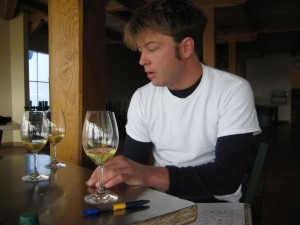Missouri’s Les Bourgeois Vineyards Profile
In 1974, Curtis and Martha Bourgeois bought a fifteen acre property on which Stephen, the fourth and youngest son, planted the first vines. When these three acres of Chambourcin grapes produced a 5 ton harvest and 500 gallons of wine, the family decided to covert a hobby into a wine making enterprise.
Today, Les Bourgeois Vineyards in Rocheport is the third biggest wine producer in Missouri, making about 135,000 gallons per year.
‘We were looking for a family business that we all could participate in,” says Curtis, Curtis Sr. and Martha’s oldest son, who was pursuing a television career in New York when he came home to join the enterprise. The younger Curtis is now the CEO of Les Bourgeois. Together with his father, he oversees the daily operation of the winery, bringing in the whole family when big decisions need to be made.
The winery’s expansion has been ongoing. By 1991, the family had its own wine making equipment and bottling facility. In 1994, a restaurant was designed by architect son, Stephen. In 1998, an adjacent 180 acre property was purchased, and this year the family finished a two year project to construct a new production facility. ‘2011 was our first crush in it,” says Curtis, ‘and it allows us to double our capacity and prepare for the future.” Currently 30% of production comes from 35 acres under vines at Les Bourgeois and the rest from grapes brought in from local growers.
This year they’re starting construction of a brewery in the space left by the old winery to house their new venture: beer. ‘We’re trying to look for new revenue streams,” says Curtis. ‘The Midwest is still behind as far as craft beer development, so we see some opportunities there. We also see the beer demographics as being different from the wine demographics, so we’re hoping to pull a different customer base.” Visitors will also have the novel experience of seeing wine and beer making processes in the same location.
But wine is very much the primary business, and Curtis says the winery’s future involves two things. ‘We’re trying to expand the wines that we can make on a larger scale and selling the higher end, small lots on the property only. This gives people another reason to come to the winery.” The larger scale wines are generally sweet and include those made with the native American Concord and Catawba grapes. The higher end, ‘Collectors Series” wines include locally grown varieties like the Norton and Vignoles as well as imported Cabernet, Shiraz, and Merlot grapes.
Curtis says the quality of one of their higher end wines, the Norton, has improved in recent years thanks to implementation of a version of a French technique called saignee. Saignee is a method of bleeding off the juice after crushing the grapes and is used to make Rose and also to reduce the liquid content of the very juicy Zinfandel grape. The technique was introduced at Les Bourgeois by winemaker Jacob Holman, originally from Moberly, Missouri. Jacob learnt his winemaking skills on the job at Les Bourgeois and at a number of smaller Missouri wineries. He calls his version of saignee “reverse bleed-off” because his objective is actually the opposite of Zinfandel makers. In other words, Jake wants to make the Norton more, not less, juicy. ‘What Jake does is take a certain percentage of the Norton grape, and he actually squeezes it just for the liquid. Then we add the liquid back into the body mass, so it gives it a much higher liquid to mass ratio and through that a cleaner fermentation.” Curtis says. “This increase in the liquid content of the Norton juice helps overcome fermentation issues caused by this grape’s high solids to liquid ratio. Through that we get a much cleaner, much more interesting, higher quality product.”
The use of winemaking techniques like reverse bleed-off that have helped improve the quality of wines, coupled with the growth of the Missouri wine industry, have transformed the way people regard the industry here compared to ten years ago, according to Curtis. ‘The business is now something that everyone recognizes as an important part of the economy and a viable concept for alternative agriculture, especially ag and ag tourism.” Another change in the last decade is the increased cooperation in research and development through the universities and the State of Missouri.. Les Bourgeois, for example, works directly with the University of Missouri in Columbia. ‘We have a pipeline for talent that is homegrown,” says Curtis. Most of the wine expertise in Missouri used to come from outside the State, from California, Australia and South Africa, and Curtis says that talent didn’t always stay in Missouri for very long. Today, there are degrees in food science and viticulture at agriculture schools which have created a new generation of Missourian winemakers who may be more likely to hang around. ‘That’s how you keep a sustainable industry going,” says Curtis. ‘It’s made a big difference for the industry and for us also.”
Even with these changes in the industry, plus the big expansion of its winery capacity, the improvements in quality and the move into craft beers, Les Bourgeois is content to distribute its wine in the Midwest. ‘We see ourselves being a regional based winery. When you’re our size you couldn’t really fill that pipeline (other regional and overseas markets) very readily so we see ourselves staying close to home,” he says. ‘The regional wine business is growing, so basically we just want to keep expanding as the pool gets bigger, and that doesn’t necessarily mean exporting much further than contiguous states.”
[wp_geo_map]





I found your Riverboat Red wine through word of mouth. Recommended by a friend, whom I am eternally grateful to, I found the best tasting chilled red wine ever to grace my palate. I have in turn played it forward by recommending it to anyone willing to listen.
Congratulations!!! You must be tickled red…..opps, that’s tickled pink.